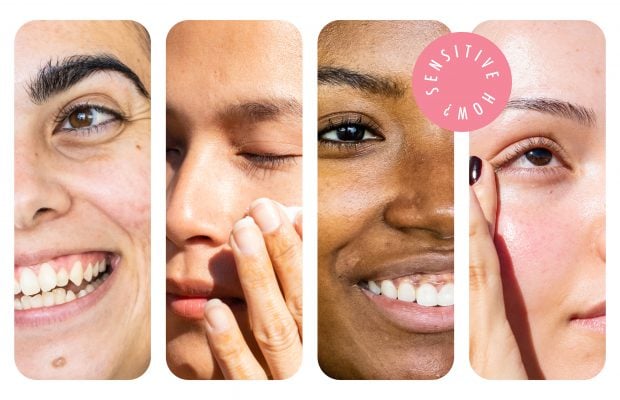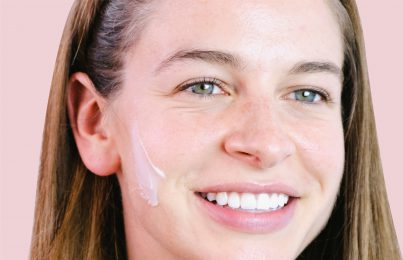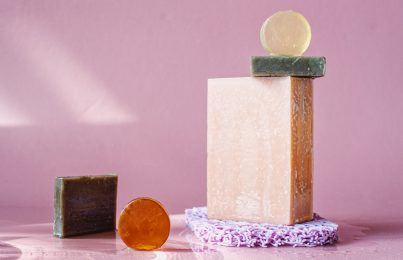Updated 05/11/23. Almost everyone thinks their skin is sensitive. In fact, whenever I ask my clients if they have sensitive skin, four out of five will say “yes.” Many of them, however, don’t know the specific type of sensitivity they’re experiencing. That’s important because, in order to best address it, you need to understand it.
What Is Sensitive Skin?
Sensitive skin is difficult to define because it can manifest in different ways. Generally speaking, though, I view sensitive skin as skin that is easily reactive (meaning you have to think twice before you slather on any new products). I would divide people with sensitive skin into two categories. There are those who truly have a genetic predisposition for sensitivity, and there are those who are causing their skin to be sensitive because of something they’re doing. Most people who struggle with sensitivity fall into the second category.
If you’re wondering whether or not you have sensitive skin, it may be helpful to know that the people who are most likely to experience sensitivity are of Northern European descent (think Irish, Scottish, and Scandinavian). This doesn’t mean you can’t experience sensitivity otherwise. It’s just a general rule of thumb to take into consideration.
The 4 Types of Skin Sensitivity
I’ve been an esthetician for over 30 years. Throughout this time, I’ve identified the four most common types of sensitivity (it’s important to note that a person can experience more than one of these sensitivities simultaneously).
1. Allergic Sensitivity
An allergy occurs when the immune system overreacts to a substance it identifies as harmful, whether that’s something internal or external (such as a skincare product). Anyone can have an allergy, so all skin types can experience this kind of sensitivity. Because your skin acts as an excretory system to get rid of things the body doesn’t agree with, food allergies can manifest on the skin. A food sensitivity can appear around the mouth, neck, or face — basically anywhere food has come into contact with your skin.
It can be tricky to address an allergic sensitivity because you ultimately need to find the root cause. This is where a little detective work comes in. Allergic reactions typically happen within 24-48 hours of coming into contact with an allergen, so it’s a good idea to retrace your steps. Keep in mind that, when it comes to skincare products, it’s unlikely to suddenly react to something you’ve been using for a long period of time, so consider anything new you’ve introduced into your routine.
Characteristics of Allergic Sensitivity
- Erythema (redness)
- Skin Rash and/or itching
- Swelling
- Hives or welts
- Skin feels hot to the touch
Common Causes of Allergic Sensitivity
- Internal inflammation (I’ve seen skin reactions triggered by birth control, IUDs, and food allergies from shellfish, strawberries, soy, and peanuts)
- Certain plant compounds found in skincare products (two common culprits are chamomile and azulene, as both are related to ragweed)
How to Deal with Allergic Sensitivity
- Stop using suspected allergens. This goes for skincare products, foods, or anything else you suspect might be causing the reaction in the first place.
- Simplify your routine. Stick to the basics. Use a cleanser and moisturizer and stop using active ingredients (like retinoids and exfoliating acids). As long as you’ve used it before, reach for the Bio Calm Repair Masque to put out the fire. Place it in the fridge before use for an extra soothing effect. (On that note, learn more about how to calm red, irritated skin.)
- Consult your doctor. If you’re experiencing swelling, itching, or discomfort, your doctor may recommend an antihistamine. If the problem persists, you can ask your doctor to perform an allergy test to get to the bottom of it.
- Find out if any of your usual products have been reformulated. I once had a client who reacted to a moisturizer she had been using for a long time. This reaction occurred right after she started using a brand new bottle. Come to find out, the company had reformulated it ever so slightly without mentioning anything to their customers about the change. It was only one ingredient, but it was enough to throw my client’s skin completely out of whack and set off an allergic response.
2. Breakout-Prone Sensitivity
If skincare products (especially those with a heavy or rich texture) cause clogged pores or breakouts, this could be you. A breakout will occur when someone’s skin produces a lot of thick, sticky oil. This traps dead skin cells in the pore-lining and keeps oxygen from circulating through the pore, which creates the perfect environment for bacteria to thrive. The underlying cause of breakouts is hard to pinpoint (here are 11 potential causes), as it can be anything from genetics to a simple case of bad luck. There are, however, certain things you can do to minimize this type of sensitivity.
Characteristics of Breakout-Prone Sensitivity
- Bumpy skin texture (closed comedones)
- Whiteheads
- Blemishes (pustules and cysts)
- Milia
Common Culprits of Breakout-Prone Sensitivity
- Sonic cleansing brushes
- Liquid foundations (especially long-wear)
- Liquid primers
- Cream blushes
- Face oils in their pure form
- Water-resistant sunscreen (especially when combined with heat from the sun)
How to Deal with Breakout-Prone Sensitivity
- Use lightweight skincare products. Avoid products that are too thick in texture, as well as heavy oils and sunscreens (especially water-resistant sunscreens).
- Don’t experiment with products too much. This will only put you at unnecessary risk for clogged pores and breakouts. Think, “if it’s not broken, don’t fix it,” and be sure to perform a patch test before introducing any new products into your routine.
- Introduce active ingredients into your routine slowly. If you’re breakout-prone and already have clogged pores, be aware that active ingredients like exfoliating acids or retinoids can cause an initial “purging.” This is when active blemishes come to the surface as the rate of cell turnover increases. This will dissipate once your skin cells get reorganized, but in order to minimize purging, you should introduce active ingredients into your routine slowly. Start with just once a week and build up from there.
- Use calming ingredients in your skincare routine. The logic behind this is that you should avoid irritation and inflammation, which can trigger breakouts. You also want to keep pores clear without drying out the skin. I recommend using the Rapid Response Detox Masque in this case. It can help disrupt the blemish cycle while also hydrating and soothing the skin.
- Educate yourself about makeup and how it affects your skin. If you wear makeup, stop doing these 12 things.
3. Heat-Activated Sensitivity
Some people have skin that is sensitive to heat. This is because heat causes an increase in blood flow to capillaries (small blood vessels just below the surface of the skin). The capillaries dilate, which makes them more visible and thus makes the skin look red. Once the internal temperature of the skin has lowered, the capillaries will constrict again, and the redness will go away. Ideally, it’s best to avoid this repeated stretching and constricting, because it can eventually lead to permanently enlarged capillaries that remain visible on the skin’s surface. If you are someone who struggles with rosacea, you will be especially prone to heat-activated sensitivity.
Characteristics of Heat-Activated Sensitivity
- Redness and flushing
- Skin feels hot to the touch
- Visible capillaries
Common Causes of Heat-Activated Sensitivity
- Intense Exercise
- Hot showers
- Sun exposure
- Saunas or steam rooms
How to Deal with Heat-Activated Sensitivity
- Avoid exposing your skin to high temperatures whenever possible. This includes avoiding hot water, intense exercise (like hot yoga), and even eating spicy foods.
- Look for products with soothing ingredients. Soothing ingredients include red marine algae, licorice extract, and sea whip (all found in the Redness Care Firming Serum).
- Manually cool your skin. Use an ice compress or try placing your products in the fridge before application, so they are cooling to the skin.
4. Dry/Dehydrated Sensitivity
The underlying cause of almost any dry/dehydrated sensitivity is a fragile or disrupted moisture barrier. When the skin’s moisture barrier is compromised, it causes microscopic cracks to appear. These cracks allow moisture to escape and irritants to penetrate the skin. This can sometimes lead to a burning or stinging sensation, which is an inflammatory reaction to something that has been applied topically to the skin.
Characteristics of Dry/Dehydrated Sensitivity
- Flaking or peeling
- Eczema-prone skin
- Itchiness
- Tightness
- Rough texture
- Stinging or burning sensation
Common Causes of Dry/Dehydrated Sensitivity
- Dry climates or airplane travel
- Changing seasons
- Ingredients such as fragrances and perfumes, some essential oils, avobenzone, or sodium lauryl sulfate
- Harsh, drying products such as foaming cleansers and prescription acne treatments
- Over-exfoliating with acids (this can lower your skin’s pH to the point where it disrupts your moisture barrier)
How to Deal with Dry/Dehydrated Sensitivity
- Cut back on exfoliation. This includes physical exfoliators like scrubs, cleansing brushes, and washcloths.
- Use a gentle cleanser. It’s important to find the right cleanser for you skin type, specifically one that won’t strip the skin of moisture. Also, avoid products that are heavily fragranced, as this can further irritate sensitive skin.
- Use a hydrating toner. The Renée Rouleau Moisture Infusion Toner is a great choice, as it’s part essence, part toner.
- Look for a moisturizer with barrier-supporting ingredients. See how the Renée Rouleau Skin Recovery Lotion improved my nephew’s skin! Wow, right?
I hope you found this helpful in understanding why your oh-so-delicate skin acts the way it does.
Next, learn more about how to avoid a negative reaction to new skincare products!
Celebrity Esthetician & Skincare Expert
As an esthetician trained in cosmetic chemistry, Renée Rouleau has spent 30 years researching skin, educating her audience, and building an award-winning line of products. Her hands-on experience as an esthetician and trusted skin care expert has created a real-world solution — products that are formulated for nine different types of skin so your face will get exactly what it needs to look and feel its best. Trusted by celebrities, editors, bloggers, and skincare obsessives around the globe, her vast real-world knowledge and constant research are why Marie Claire calls her “the most passionate skin practitioner we know.”



